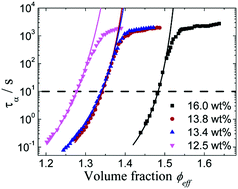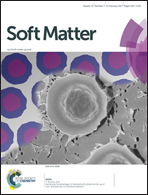Long-term aging behaviors in a model soft colloidal system
Abstract
Colloidal and molecular systems share similar behaviors near to the glass transition volume fraction or temperature. Here, aging behaviors after volume fraction up-jump (induced by performing temperature down-jumps) conditions for a PS–PNIPAM/AA soft colloidal system were investigated using light scattering (diffusing wave spectroscopy, DWS). Both aging responses and equilibrium dynamics were investigated. For the aging responses, long-term experiments (100 000 s) were performed, and both equilibrium and non-equilibrium behaviors of the system were obtained. In the equilibrium state, as effective volume fraction increases (or temperature decreases), the colloidal dispersion displays a transition from the liquid to a glassy state. The equilibrium α-relaxation dynamics strongly depend on both the effective volume fraction and the initial mass concentration for the studied colloidal systems. Compared with prior results from our lab [X. Di, X. Peng and G. B. McKenna, J. Chem. Phys., 2014, 140, 054903], the effective volume fractions investigated spanned a wider range, to deeper into the glassy domain. The results show that the α-relaxation time τα of the samples aged into equilibrium deviate from the classical Vogel–Fulcher–Tammann (VFT)-type expectations and the super-Arrhenius signature disappears above the glass transition volume fraction. The non-equilibrium aging response shows that the time for the structural evolution into equilibrium and the α-relaxation time are decoupled. The DWS investigation of the aging behavior after different volume fraction jumps reveals a different non-equilibrium or aging behavior for the considered colloidal systems compared with either molecular glasses or the macroscopic rheology of a similar colloidal dispersions.



 Please wait while we load your content...
Please wait while we load your content...